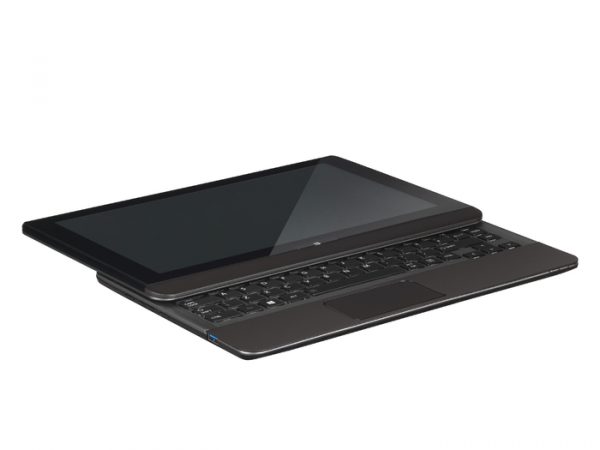By charting the course of technology over the last several years and predicting its continued path, it’s fair to say that we have an interesting year ahead of us.
The largest shift will take place in how we interact with computers. Touch screens on smartphones and tablets brought in human touch, Siri popularized voice-controlled systems, and the hacker community has begun to advance thought-controlled computing with EEG headsets. Voice, touch, and thought will slowly join the keyboard and mouse as ways to interact with electronics, and 2013 will see a new level in this shift.
The other major shift will be the return of the robotics market—starting with the popularization of drones and robots as toys.
Rise of the Hybrids
Let’s face it, laptops are just too heavy and too clumsy when there’s not a desk or table nearby. But tablets aren’t perfect either. Sometimes we need more power, so we use both a tablet and a notebook. And sometimes we just need a keyboard, so we’ve found ourselves attaching keyboards to our tablets, which ironically makes them not much different from notebooks.
Thus, from the rift between tablets and notebooks, the hybrid emerged. These are touch-screen notebooks that convert into tablets, such as the Toshiba U925t, Asus Taichi, and Sony Tap 20. When you need a notebook, they become notebooks. When you need a tablet, they become tablets.
Hybrids are just starting to become practical, however, and this is thanks to Windows 8. The major hurdle with hybrids is the operating system—do you use a full-fledged operating system, or one meant for mobile devices and tablets? Windows 8 includes both, allowing users to switch between a conventional Windows interface and a spiffy new one ideal for touch screens.
In 2013, expect to see Microsoft dominate the hybrid market. Since Mac OSX is only usable on Apple computers, Apple will not create a hybrid operating system until they release a hybrid computer. As for Google, its flagship operating system, Android, is intended for smartphones and tablets, and until they release a hybrid Chromebook, it is also unlikely they will release a hybrid operating system.
Yet, as developers shift the market to hybrid computers and touch screen notebooks, Apple and Google will need to follow Microsoft’s lead or risk falling behind. It is likely both companies will release hybrid operating systems—paired with hybrid computers—by 2014, although they may appear in 2013 if Microsoft’s hybrids outpace the popularity of their own devices.
EEGs and Thought-Controlled Computing
When Emotiv first announced the EPOC in 2008, it was backed by a new vision of human-computer interaction. The headset with 14 electrodes uses electroencephalography (EEG) technology to detect the electric signals emitted by the brain, and translates these into computer commands. It allows users to control their computers with thoughts, emotions, and subtle movements.
At just $300, the EPOC was meant to bring EEG technology into the mainstream. Yet, it was too far ahead of its time. It was written off as more of a novel science fiction concept than a practical tool.
Despite the mainstream market never taking to EEGs, the technology was kept alive by the U.S. military, health researchers, and a small circle of software developers. And the odd inventions of this community have brought EEG systems into the public eye.
Videos of people using prosthetic limbs using their thoughts have gone viral. Researchers, such as the folks from the CNRS-AIST Joint Robotics Laboratory are creating thought-controlled robots that can be used like real-world avatars by paralyzed people.
And now, a new hip-looking EEG headband is on its way to the mainstream market. After nearly doubling its goal on crowd-funding website, Indiegogo, the MUSE indents to make EEG systems not only practical, but also stylish.
With its four electrodes, the MUSE sends your brainwave data to your smartphone or tablet and lets you see how your brain is performing, similar to a heart rate monitor. The MUSE is also open to software developers, and the more you use it, the more accurate it becomes. InteraXon, the company behind the MUSE, is working on accompanying technology that will let users use the MUSE with their phones or televisions—maybe allowing them to turn off a television if they drift off to sleep.
In 2013, EEG technology will begin drawing more attention, although it will likely not become mainstream until 2015. Health systems using EEG technology will become much more prominent in 2013, however, particularly among paralyzed people and for individuals, thanks to the already growing community of independent developers.
Voice Recognition Features
Voice recognition software is by no means new. Software developers such as Nuance have been working on it for years, Microsoft Word 2002 had speech recognition features, and even your pre-smartphone phone likely had speech recognition features built in. But the technology never got much attention until Apple announced Siri’s integration into the iPhone 4S in 2011.
Siri changed the landscape for voice recognition, although the system did little if anything different from pre-existing tools—even Siri itself started off as an app in the App Store that was available on all iPhone models. Siri’s popularity, however, was fueled by clever marketing, and its charm was in its near seamless integration into the iPhone 4S.
Along with Siri’s popularization, so too is growing the popularity of voice recognition systems on other platformers, including Android.
In 2013, expect voice recognition systems to grow more popular on smartphones and tablets. As people grow more accustomed to voice-to-text systems, and the ability to control computer functions with voice, expect voice recognition to begin growing more popular on laptops and notebooks by early 2014.













